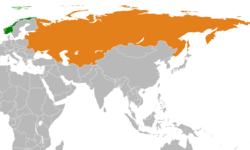Norway–Soviet Union relations
 | |
Norway |
Soviet Union |
|---|---|
Norway–Soviet Union relations refers to the historical
Timeline
A 2013 article in the Norwegian newspaper Dagbladet said that the autumn of 1951 removal of more than 8,000 Soviet corpses from graves in North Norway, Operation Asphalt, led to "the toughest diplomatic conflict ever between Norway and Soviet".[2]
Strains in bilateral relations

Both the environmentally devastating emissions from the
Disagreements concerning the interpretation of the
Border
The two countries retained a 195.7-kilometer-long (121.6 mi) land border between Sør-Varanger and Murmansk Oblast.[8] There was only one legal crossing point, at Storskog (Norway) and Boris Gleb (Russia), on the E105 road some 15 km east of Kirkenes.
The border between Norway and the Soviet Union in the Varangerfjord was agreed upon in a treaty from 1957.[9] Negotiations on the outside marine border were initiated in 1970. Norway claimed, in accordance with the United Nations Convention on the Law of the Sea Article 15 and the Convention on the High Seas, that the border should follow the midline principle, the border being defined by midpoints between the nearest land area or islands, as is normal practice internationally. The Soviet Union claimed, based on a decision by Joseph Stalin from 1926, which was not recognized by any other country than the Soviet Union,[10] that a "sector principle" should apply, such that the border should follow meridian lines. Most of the disputed area was within what would normally be considered Norwegian according to the relevant international treaties.[citation needed] In 1975 the two countries agreed upon a moratorium prohibiting exploration for oil and gas in the disputed area.
In 1978 a temporary agreement regulating
See also
References
- ^ a b Norwegian embassy
- ^ 60 års taushet og tristesse
- ^ Antonova, Maria (July 25, 2008). "Balancing Growth and Environment". The Moscow Times. Archived from the original on 2008-08-03. Retrieved April 27, 2010.
- ^ Norway, Russia agree on Barents Sea border[permanent dead link]
- ^ Kunne besette Finnmark på tolv timer, Jakob Arvola
- ^ Tamnes, Rolf (1992). Svalbard og den politiske avmakt. Oslo: Institutt for forsvarsstudier. pp. 84–87.
- ISBN 82-412-0540-6.
- Norwegian Mapping and Cadastre Authority. Archived from the originalon 3 September 2014. Retrieved 29 April 2010.
- ^ "Agreement between Norway and the Soviet Union concerning the sea frontier between Norway and the Soviet Union in the Varangerfjord". 29 November 1957. Retrieved 29 April 2010.
- ^ "Tror på gråsoneavklaring". April 2010.
- ^ "Gjennombrudd i Barentshavet". Dagens Næringsliv (in Norwegian). 28 April 2010. pp. 6–13.
- ^ "- Dette er mange fjær i hatten for Jens". 27 April 2010.
- ISBN 9788202204600[page needed]
- ISBN 9788202299880, pp. 35–36 and p. 135
- ISBN 82-995068-0-8[page needed]


